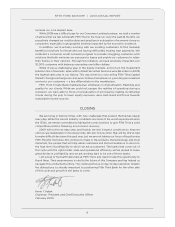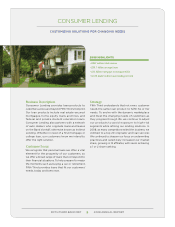Fifth Third Bank 2008 Annual Report Download - page 18
Download and view the complete annual report
Please find page 18 of the 2008 Fifth Third Bank annual report below. You can navigate through the pages in the report by either clicking on the pages listed below, or by using the keyword search tool below to find specific information within the annual report.
MANAGEMENT’S DISCUSSION AND ANALYSIS OF FINANCIAL CONDITION AND RESULTS OF OPERATIONS
16 Fifth Third Bancorp
preferred stock and certain bank trust preferred
securities;
• $76 million of other noninterest income, partially offset
by $36 million in related litigation expense, due to the
successful resolution of a court case related to goodwill
created in the 1998 acquisition of CitFed (the CitFed
litigation); and
• Preferred stock dividends increased from $1 million to
$67 million in 2008 due to the issuance of Series G
preferred stock in the second quarter of 2008 and
repurchase of Series D and Series E preferred stock in
the fourth quarter of 2008. The repurchase of Series D
and Series E preferred stock resulted in preferred stock
dividends of $19 million, which was the amount of the
repurchase price in excess of the par value of the
preferred stock.
For comparison purposes, items affecting 2007 include:
• $177 million reduction to other noninterest income to
reflect the lower cash surrender value of one of the
Bancorp’s BOLI policies;
• $172 million of other noninterest expense relating to the
indemnification of estimated current and future Visa
litigation settlements;
• $16 million of noninterest income from the sale of non-
strategic credit card accounts; and
• $15 million of other noninterest income from the sale of
FDIC deposit insurance credits.
Net interest income (FTE) increased to $3.5 billion, from
$3.0 billion in 2007. The primary reason for the 17% increase in
net interest income was an 11% increase in average interest-
earning assets. Additionally, the benefit from the accretion of
purchase accounting adjustments related to the second quarter
acquisition of First Charter, totaling $358 million, was largely
offset by $130 million in charges relating to leveraged leases and
the cost of carrying higher balances of nonaccrual loans and
leases. Net interest margin was 3.54% in 2008, an increase of 18
basis points (bp) from 2007.
Noninterest income increased 19%, from $2.5 billion to $2.9
billion, in 2008. The increase in noninterest income was impacted
by a $273 million gain related to the redemption of a portion of
Fifth Third’s ownership interests in Visa, offset by $104 million
due to OTTI charges on FNMA and FHLMC preferred stock and
certain bank trust preferred securities. Growth occurred in several
categories compared to 2007. Electronic payment processing
revenue increased 11% due to higher transaction volumes.
Service charges on deposits grew 11% due to decreased earnings
credits and higher customer activity. Corporate banking revenue
increased 21% as the Bancorp realized growth from the buildout
of its suite of commercial products in 2007. Mortgage banking
net revenue increased 50% due to higher sales margins, increased
volume of portfolio loans sold and the impact of Statement of
Financial Accounting Standards (SFAS) No. 159, “The Fair Value
Option for Financial Assets and Financial Liabilities - Including an
Amendment of FASB Statement No. 115”.
Noninterest expense increased $1.3 billion compared to
2007. Noninterest expense in 2008 included $965 million of
noninterest expense due to a goodwill impairment charge, the
aforementioned $99 million reduction to expenses related to Visa
litigation reserves and Visa’s funding of an escrow account, $65
million increases in salaries and benefits from the adoption of
SFAS No. 159, and $36 million in litigation expense due to the
successful resolution of the CitFed litigation. Noninterest
expense in 2007 included $172 million related to the
indemnification of estimated current and future Visa litigation
settlements. The growth in noninterest expense can also be
attributed to increased FDIC insurance due to the depletion of the
Bancorp’s prior FDIC insurance premium credits in 2008, a
higher provision for unfunded commitments, increases in the
credit component of fair value marks on counterparty derivatives,
increases in loan and lease processing costs from higher collection
activities over the past year and increased volume-related
processing expenses.
The Bancorp does not originate subprime mortgage loans,
does not hold credit default swaps and does not hold asset-backed
securities backed by subprime mortgage loans in its securities
portfolio. However, the Bancorp has exposure to disruptions in
the capital markets and weakening economic conditions. The
housing markets continued to weaken during 2008, particularly in
the upper Midwest and Florida. Additionally, economic conditions
deteriorated throughout 2008, putting significant stress on the
Bancorp’s commercial and consumer loan portfolios.
Consequently, the provision for loan and lease losses increased to
$4.6 billion for the year ended December 31, 2008 compared to
$628 million during 2007. Net charge-offs as a percent of average
loans and leases were 3.23% in 2008 compared to .61% in 2007.
At December 31, 2008, nonperforming assets as a percent of
loans, leases and other assets, including other real estate owned
(excluding nonaccrual loans held for sale) increased to 2.96%
from 1.32% at December 31, 2007. During the fourth quarter of
2008, the Bancorp sold or transferred to held-for-sale $1.3 billion
in carrying value of commercial loans and incurred $800 million in
charge-offs on those loans, in order to address some of the more
problematic loan portfolios, specifically real estate loans in Florida
and Michigan. Refer to the Credit Risk Management section in
Management’s Discussion and Analysis for more information on
credit quality.
In response to the current economic operating environment
and uncertain future trends, the Bancorp took actions to
strengthen its capital position in 2008. During the second quarter
of 2008, management raised its capital target to an eight to nine
percent Tier 1 capital ratio and issued approximately $1.0 billion
in Tier 1 capital in the form of convertible preferred shares.
During 2008, the Bancorp reduced its common dividend due to
the outlook for a continued negative credit environment,
preserving over $580 million of capital in 2008 relative to the prior
level, and nearly $1.0 billion in 2009. On December 31, 2008, the
Bancorp received $3.4 billion as part of the U.S. Department of
Treasury (U.S Treasury) Capital Purchase Program (CPP) and
issued senior preferred stock and ten-year warrants under the
terms of the program - impacting the Bancorp’s Tier 1 capital
ratio and total risk-based capital ratio by approximately 3.00%.
The Bancorp’s capital ratios exceed the “well-capitalized”
guidelines as defined by the Board of Governors of the Federal
Reserve System (FRB). As of December 31, 2008, the Tier 1
capital ratio was 10.59%, the Tier 1 leverage ratio was 10.27% and
the total risk-based capital ratio was 14.78%.
RECENT ACCOUNTING STANDARDS
Note 1 of the Notes to Consolidated Financial Statements
provides a discussion of the significant new accounting standards
adopted by the Bancorp during 2008 and 2007 and the expected
impact of significant accounting standards issued, but not yet
required to be adopted.
























